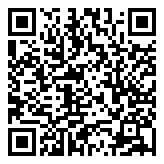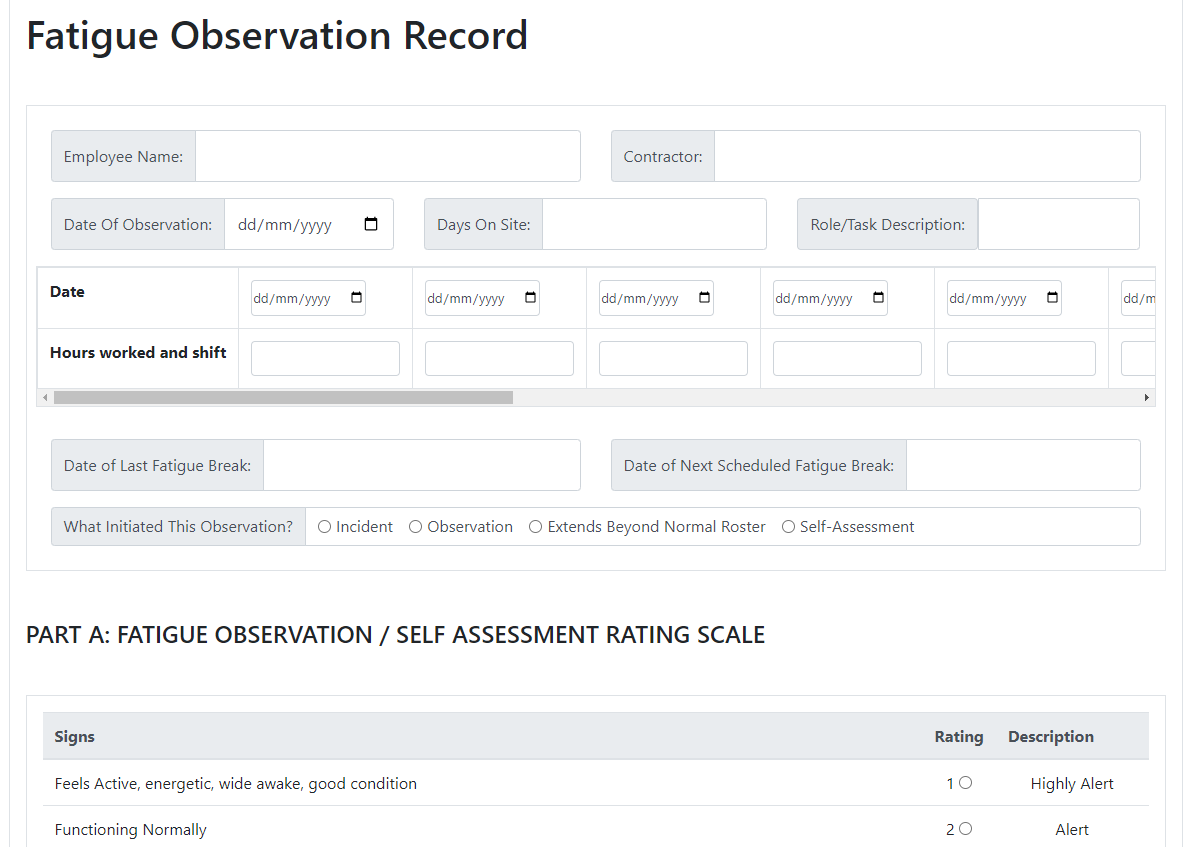Online Induction >> Fatigue Self Assessment
Published 19/05/2023
Fatigue Self Assessment - Calculator, Form and Setup
Management and prevention of fatigue in the workplace is now a WHS issue that requires diverse organizational approaches. Generally, employers have the mandate to identify, minimize, or eliminate fatigue-related risks in the workplace. The adverse effects of fatigue are far-reaching and usually expand beyond the workplace. Fatigue isn't necessarily the kind of tiredness to be solved by a single cup of coffee but a severe problem that requires a systematic approach.
Fatigue Calculator Templates
Try our online fatigue self assessment calculator right here. Here you could set up a calculator for your workplace for staff to conduct a self assessment on fatigue. Try creating your own custom fatigue assessment questions or use our online template or ready to go calculator.
You might include a fatigue calculator as a safety tool as part of your
Induction Program.

Sample Fatigue Self Assessment Calculator
Try scanning this QR code for a sample fatigue self assessment

What is fatigue?

In the workplace setting, we can define fatigue as a state of physical and mental exhaustion that usually reduces employees' potential to perform their work effectively and safely. Fatigue involves more than just feeling drowsy and tired.
Multiple factors cause fatigue which can either be personal or work-related:
- Sleep disorders
- Strenuous jobs
- Prolonged physical and mental activity
- Long commuting times
- Organizational changes
- Alcohol and drugs
Work health and safety guidelines are designed to ensure the safety of everyone in the workplace. All the staff needs to be aware of their fatigue risks. Although certain fatigue levels tend to be normal responses to our everyday lives, moderate to high fatigue levels result in a range of adverse outcomes for a worker.
Knowing how to manage and prevent fatigue-related risks through education and training is essential in ensuring continuous improvement and prevention of incidents. This greatly influences the development of a strong safety culture focused on every active staff's safety, health, and well-being in the workplace. Staff needs to be constantly reminded of the consequences of fatigue. This can be done through occasional meetings and check-ups to cover the importance of sleep, alertness, and exercise strategies.
The common signs and symptoms of fatigue are:
- Reduced alertness
- Lack of motivation
- Headaches
- Increased mistakes
- Low concentration or memory
Fatigue self assessment calculator

Consequences of fatigue are likely to cause incidents and accidents in the workplace. Thus, it's necessary to calculate or assess and monitor fatigue, both physical and mental, during prolonged, demanding jobs. Assessment can be done through electrocardiography or electroencephalography, but these strategies are complex and intrusive. This is because they require preparation, data processing, and careful analysis.
We know that fatigue has detrimental effects, which include:
- Reduced productivity
- Decreased cognitive performance
- Cardiovascular diseases
- depression
So, an organization may opt for a more subjective and straightforward method such as self-assessment questionnaires and online fatigue assessment tools. The majority of self-assessment tools typically consist of items about physical and mental fatigue.
Self-tests help workers know if they are at the risk of falling victim to fatigue by establishing how they feel about their job and various experiences at work.
The questionnaire typically consists of a specific number of items (e.g., 9) related to how fatigue interferes with your job activities and has a self-report scale to rate its severity. The items are scored on scales of 7 points (1-strongly disagree/7-strongly agree). Generally, the maximum score is 63, while the minimum possible score is 9. Higher scores translate to greater fatigue severity and vice versa. From the scores, staff can be in a position to determine whether they are at risk of fatigue or not.
Example Fatigue Self Assessment Questions
Here are some example fatigue self assessment questions and rating fields:
1. Fatigue Observation / Self-Assessment Rating (use Part A answer from above)
2. How many hours of sleep did you have prior to your last shift?
3. How many hours sleep have you had in the last 48 hours (2 days)?
4. How many alcoholic drinks did you drink before your last sleep?
5. Are you taking medication that could make you drowsy, contribute to fatigue?
6. Are you feeling affected by any other additional contributing factors of fatigue (e.g. noise, vibration, heat/cold, working alone, repetitive task, physically demanding job etc.)?
7. Are you subject to non-work-related personal factors resulting in a loss of focus/mental fatigue (e.g. family illness, financial issues, relationship troubles etc)?
8. Are there external factors influencing you not taking your normal scheduled roster break (e.g. financial reward of staying on site, you feel obligated, back-to-back not able to return to site etc)?

How can a Fatigue Calculator help prevent issues in the workplace?
Sometimes, workers tend to work while fatigued due to staff shortages and the demands of the job. This, in turn, is very risky as working while already tired trigger accidents. For instance, fatigue in doctors might result in needlestick injuries, medical errors, and vehicle accidents.
Online self-assessment tools, for example, can help the staff determine if they are at risk of fatigue. Any worker who uses fatigue self-assessment tools receives online assessments of the fatigue risks of their job schedule. Those who get assessed as being at risk should raise the issue with the organization's management.
An exhausted worker is encouraged to get help or rest to prevent the life-threatening incidents they might cause in the workplace. Having assessment tools helps safety management teams make the necessary workplace changes and play more active roles in ensuring worker safety to create a more conducive working environment.
Currently, fatigue in the workplace is a significant problem primarily due to long work periods, high-demand tasks, and accumulative sleep debt that's common in many organizations. This is why it's critical for every workplace to implement a fatigue self-assessment approach and ensure awareness to reduce and eliminate its risks.
Try setting up an online Fatigue self assessment tool
Create your first one from scratch or use one from our existing Fatigue self assessment tool



 In the workplace setting, we can define fatigue as a state of physical and mental exhaustion that usually reduces employees' potential to perform their work effectively and safely. Fatigue involves more than just feeling drowsy and tired.
In the workplace setting, we can define fatigue as a state of physical and mental exhaustion that usually reduces employees' potential to perform their work effectively and safely. Fatigue involves more than just feeling drowsy and tired.
 Consequences of fatigue are likely to cause incidents and accidents in the workplace. Thus, it's necessary to calculate or assess and monitor fatigue, both physical and mental, during prolonged, demanding jobs. Assessment can be done through electrocardiography or electroencephalography, but these strategies are complex and intrusive. This is because they require preparation, data processing, and careful analysis.
Consequences of fatigue are likely to cause incidents and accidents in the workplace. Thus, it's necessary to calculate or assess and monitor fatigue, both physical and mental, during prolonged, demanding jobs. Assessment can be done through electrocardiography or electroencephalography, but these strategies are complex and intrusive. This is because they require preparation, data processing, and careful analysis.

